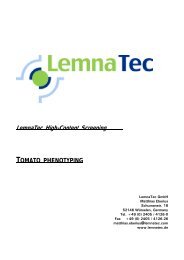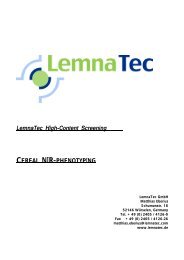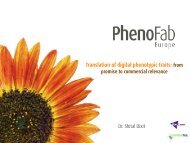High throughput Arabidopsis Phenotyping - LemnaTec
High throughput Arabidopsis Phenotyping - LemnaTec
High throughput Arabidopsis Phenotyping - LemnaTec
Create successful ePaper yourself
Turn your PDF publications into a flip-book with our unique Google optimized e-Paper software.
<strong>LemnaTec</strong> <strong>High</strong>-Content Screening<br />
ARABIDOPSIS<br />
MORPHOLOGICAL PHENOTYPE ASSESSMENT<br />
<strong>LemnaTec</strong> GmbH<br />
Matthias Eberius<br />
Schumanstr. 18<br />
52146 Würselen<br />
02405 / 4126-0<br />
matthias.eberius@lemnatec.de<br />
www.lemnatec.de
Automated quantitative phenotyping of complete plants<br />
<strong>LemnaTec</strong>’s new Morphological Assessment Toolbox (MAT) provides an almost unlimited<br />
set of morphological parameters easily to be correlated with biological effects.<br />
The great number of different, automatically quantifiable parameters allows<br />
comprehensive, high-content screening, statistics on morphological patterns and changes<br />
of these patterns over time.<br />
The following examples are parameterised for <strong>Arabidopsis</strong>, but similar approaches are<br />
available for a wide range of other biological applications.<br />
In all cases data are shown in an xy-graph to visualise the parametric values and show<br />
examples of group forming, depending on which parameter is used and which<br />
morphological traits are to be grouped. Analysing greater numbers of plants with<br />
advanced statistical grouping procedures makes multidimensional grouping possible,<br />
based on data provided by the <strong>LemnaTec</strong> Morphological Assessment Toolbox. Such<br />
datasets are ideal to use in QTL-studies, when unbiased, reproducible datasets on great<br />
numbers of samples are needed. While the parameters shown below are intended to be<br />
discernable by the human eye, further analysis and especially correlations between<br />
parameters may reveal highly significant correlation not so easily to be “seen”, but<br />
presumably useful if a biological correlation can be found.<br />
Moreover, if any additional visual phenotype is found during screening later on, one that<br />
has not yet been clearly represented in any parameter analysed and quantified, the<br />
storage of all images will allow a consistent reanalysis of ALL images of ALL plants ever<br />
grown within the imaged screening project. This conservation of raw data can<br />
dramatically reduce costs and time of screening programs, increasing the significance and<br />
worth of the library of screened plants, as costly repetitions of experiments are<br />
unnecessary. On the other hand, quantitative reproducible analysis allows for a high-level<br />
quality control, e. g. by monitoring growth conditions with control plants or testing<br />
biological reproducibility of phenotype development.<br />
All following parameters are referring to complete plants. Phenotype traits related to<br />
growth patterns and single leaf morphology are presented in other application papers.<br />
2
<strong>LemnaTec</strong> would like to thank Prof. Eevi Rintmäki from the University of Turku for the<br />
basic image with different <strong>Arabidopsis</strong> phenotypes shown in figures 1–8,10.<br />
Compactness<br />
Compactness is calculated based on the rotational momentum of the plant, irrespective of<br />
size . Figure 1 shows compactness versus area of the plant.<br />
compactness<br />
0,6<br />
0,5<br />
0,4<br />
0,3<br />
0,2<br />
0,1<br />
0<br />
0 20.000 40.000 60.000 80.000 100.000 120.000<br />
area<br />
Fig. 1: Display of compactness<br />
versus plant leaf area (left).<br />
Colours in the diagram correlate<br />
with colours of the plants shown<br />
below<br />
Compactness describes if the leaves are nearer around the centroid or farther away from<br />
it, e. g. by having longer stipes. The orange plant in this case is separated from the red<br />
plants by its size, which shows how grouping criteria can be defined for separating<br />
phenotype traits. As being size-independent, the compactness value itself is in the same<br />
range for both the red and the orange plant classes. While the green plants are obviously<br />
quite compact, the yellow plant is an intermediate, which is clearly reflected in the<br />
parameter for compactness.<br />
A01<br />
A02<br />
A03<br />
A04<br />
A05<br />
B01<br />
B02<br />
B04<br />
B05<br />
3
Rotational Symmetry<br />
Rotational symmetry of the complete plant is calculated based on the size-independent<br />
second moment principal axis ratio. This parameter integrates about the whole shape of<br />
the plant and is size-independent.<br />
symmetry<br />
20<br />
18<br />
16<br />
14<br />
12<br />
10<br />
8<br />
6<br />
4<br />
2<br />
0<br />
0 20.000 40.000 60.000 80.000 100.00<br />
0<br />
area<br />
120.00<br />
0<br />
Fig. 2: Display of symmetry versus<br />
plant leaf area (left). Colours in the<br />
diagram correlate with colours of<br />
the plants shown below<br />
Rotational symmetry describes in how far the leaves as a whole show a symmetric plant.<br />
It can be easily seen that this leads to a completely different grouping than the<br />
compactness mentioned before. Now the two blue-marked plants are distinctly separated<br />
from all others due to their two predominant leaves. But even smaller differences as<br />
between the red and orange plants are reflected in the data providing a higher value for<br />
the orange one. Up to which degree such differences in value have a distinct biological<br />
basis or are just normal biological variability is an interesting scientific question, to be<br />
answered by analysing greater higher numbers of plants from the same strain under<br />
similar conditions. As continuous reproducible data is provided by the <strong>LemnaTec</strong><br />
Scanalyzer HTS software, any small difference can be identified and used as a classifier,<br />
as long as statistics identify it as significant. This may show up quite important new<br />
perspectives, e. g. for QTL-analysis, and can also help experienced phenotype assessors<br />
to turn their experience and intuition into definite quantitative numbers.<br />
A01<br />
A02<br />
A03<br />
A04<br />
A05<br />
B01<br />
B02<br />
B04<br />
B05<br />
4
Excentricity<br />
While calculated with a different algorithm, eccentricity (fig. 3) provides grouping results<br />
quite similar to those of rotational symmetry (see fig. 2 above).<br />
excentricity<br />
Fig. 3: Display of excentricity<br />
versus plant leaf area (left). Colours<br />
in the diagram correlate with<br />
colours of the plants shown below<br />
Nevertheless the orange plant A02 shows more significant separation from A01 and A03<br />
(red) than with rotational symmetry. This example demonstrates that having a wide range<br />
of morphological algorithms available is convenient for finding the most appropriate<br />
classification parameter.<br />
Surface Coverage<br />
Surface coverage compares the plant area to the area of a circle covering the plant.<br />
surcace coverage max circle<br />
0,9<br />
0,8<br />
0,7<br />
0,6<br />
0,5<br />
0,4<br />
0,3<br />
0,2<br />
0,1<br />
0<br />
0 20.000 40.000 60.000 80.000 100.00<br />
0<br />
0,8<br />
0,7<br />
0,6<br />
0,5<br />
0,4<br />
0,3<br />
0,2<br />
0,1<br />
Fig. 4: Display of surface<br />
coverage versus plant leaf area<br />
(left). Colours of the diagram<br />
and of the plants correlate<br />
This parameter is intended to provide a value that shows how dense the plant covers the<br />
soil in its immediate growth area. While it is extremely obvious that the green plants are<br />
the most dense, it is interesting to see that the coverage of the highly asymmetrical<br />
plants is not so much lower than that of plants A02 and A04 (all red), despite of the<br />
great asymmetry.<br />
0<br />
area<br />
0 20.000 40.000 60.000 80.000 100.00<br />
0<br />
area<br />
120.00<br />
0<br />
120.00<br />
0<br />
A01<br />
A02<br />
A03<br />
A04<br />
A05<br />
B01<br />
B02<br />
B04<br />
B05<br />
A01<br />
A02<br />
A03<br />
A04<br />
A05<br />
B01<br />
B02<br />
B04<br />
B05<br />
5
Medium Leaf Width Index<br />
The medium leaf width index is calculated as the square of the length of the plant<br />
skeleton divided by the plant area. For this purpose, the plant skeleton is derived from the<br />
entire plant area by image processing, as shown in fig. 4.<br />
medium leaf width index<br />
1,2<br />
1<br />
0,8<br />
0,6<br />
0,4<br />
0,2<br />
0<br />
0 20.000 40.000 60.000 80.000 100.000 120.000<br />
area<br />
Fig. 5: Plant area and plant<br />
skeleton, derived by image<br />
processing<br />
Fig. 6: Display of medium leaf<br />
width index versus plant leaf area<br />
(left). Colours in the diagram<br />
correlate with colours of the<br />
plants shown below<br />
The medium leaf width index describes size-independent differences of „leaf width“,<br />
integrating stipes, leaves and overlapping effects. While the blue plant has the smallest<br />
leaves, but comparatively long stipes, it produces very high values, whereas the other<br />
plants show smaller differences in the index, especially the yellow and green ones<br />
separated by size. This corresponds well to the visual impression that leaf width<br />
integrating the stipes is relatively similar for these plants. The red and orange plants show<br />
higher values as leaves are smaller and stipes shorter and relatively thicker.<br />
A01<br />
A02<br />
A03<br />
A04<br />
A05<br />
B01<br />
B02<br />
B04<br />
B05<br />
6
Area/Circumference<br />
While having some size-dependency left, the ratio of leaf area divided by plant<br />
circumference may allow for additional classification of morphological traits.<br />
area / circumfence<br />
50<br />
45<br />
40<br />
35<br />
30<br />
25<br />
20<br />
15<br />
10<br />
5<br />
0<br />
0 20.000 40.000 60.000 80.000 100.00<br />
0<br />
Fig. 7: Display of area divided by<br />
circumference versus plant leaf<br />
area (left). Colours in the diagram<br />
correlate with colours of the<br />
plants shown below<br />
This grouping is a good example of plant grouping according to more than two<br />
morphological parameters, which can be displayed and used in a xy–graph. The best way<br />
to do this is by producing a reasonable ratio of two parameters. This can be achieved<br />
quite easily with the <strong>LemnaTec</strong> HTS Bonit software, displaying a secondary-derived<br />
morphological parameter like the ratio. Identifying such parameters and ratios provides a<br />
wide range of related parameters to be tested in QTL-studies for correlation to molecular<br />
biological data.<br />
area<br />
In some cases it is of special interest to keep a phenotypic parameter related to size,<br />
especially if the parameter on the x-axis is not size, but for example age of the plant or<br />
the cumulative water use in drought or water efficiency studies. These examples show<br />
the power of readily available quantitative data, and these are easily produced by the<br />
automated <strong>LemnaTec</strong> image processing.<br />
120.00<br />
0<br />
A01<br />
A02<br />
A03<br />
A04<br />
A05<br />
B01<br />
B02<br />
B04<br />
B05<br />
7
Stockiness<br />
Stockiness is in a mathematical sense the description of roundness. But the term<br />
roundness is much better applicable to, for example, egg-shaped objects in comparison to<br />
perfect circles<br />
stockiness<br />
160<br />
140<br />
120<br />
100<br />
80<br />
60<br />
40<br />
20<br />
0<br />
Fig. 8: Display of area divided by<br />
circumference versus plant leaf area<br />
(left). Colours in the diagram correlate<br />
with colours of the plants shown<br />
below<br />
When applying standard morphological algorithms to biological objects, biological<br />
interpretation of the parameters is often needed. Applied to <strong>Arabidopsis</strong> images<br />
stockiness separates plants with invisible or relatively short, broad stipes from plants with<br />
long, smaller stipes.<br />
0 20.000 40.000 60.000 80.000 100.00<br />
0<br />
While the green plants have long stipes and long leaves, the blue plants have rounder<br />
leaves and comparatively shorter stipes. With the red plants stipes are shorter and wider,<br />
if to be discerned at all.<br />
area<br />
120.00<br />
0<br />
A01<br />
A02<br />
A03<br />
A04<br />
A05<br />
B01<br />
B02<br />
B04<br />
B05<br />
8
Application to Separate Two Groups<br />
The aim of the following example is just to separate two groups from each other. This<br />
method reveals that using stockiness and compactness as a separating factor for the two<br />
groups is working very well.<br />
Fig. 9: The upper left image displays the leaf<br />
area image as produced by the <strong>LemnaTec</strong> HTS<br />
Bonit software. The image below shows a<br />
classification of two groups in blue and<br />
yellow, discriminating long leaf plants from<br />
round leaf plants. The plant highlighted in red<br />
seems to be an outlier from the grouping<br />
scheme in the tray, which is clearly<br />
represented in the numerical graph below<br />
plotting stockiness versus compactness<br />
stockiness<br />
100<br />
90<br />
80<br />
70<br />
60<br />
50<br />
40<br />
30<br />
20<br />
10<br />
0<br />
0,6 0,65 0,7 0,75 0,8 0,85 0,9 0,95<br />
compactness<br />
9
Conclusions<br />
1. With the new Morphological Assessment Toolbox MAT <strong>LemnaTec</strong> provides a very<br />
powerful tool to assess a wide range of plant morphological parameters. Different<br />
morphological parameters allow for reproducible and different groupings of the<br />
plants easily to be visualised. This paper focuses on a selection of complete plant<br />
parameters like compactness, rotational symmetry, excentricity, surface coverage,<br />
medium leaf width index, area/circumference or stockiness. More parameters<br />
focussing on single leaves are discussed elsewhere.<br />
2. Quantitative and reproducible assessment permits application of advanced grouping<br />
algorithms. Each quantitative parameter refers to a different morphological trait and<br />
may be used in high-content screening, e. g. for QTL-analysis.<br />
Fig. 10: Different<br />
morphological parameters<br />
classify plants in different<br />
phenotypic groups<br />
3. As all images are stored and thus a tremendous amount of raw data is retained<br />
after a test, the <strong>LemnaTec</strong> image systems permit consistent reanalysis of ALL data<br />
over very extensive and long screenings, even if some of the parameters to be<br />
assessed are not yet known at the start of the screening. This library of screened<br />
plants is a tremendous treasure for each lab, because it shortens screening times<br />
and reduces costs, at the same time. No tests have to be repeated due to<br />
additional assessments that emerged while screening was already in progress.<br />
4. Routine use of control samples allows for automatic and quantitative quality control<br />
of test conditions. This maximises quality and reproducibility of the test results.<br />
For further information, please do not hesitate to contact:<br />
Matthias Eberius, <strong>LemnaTec</strong><br />
matthias.eberius@lemnatec.de<br />
10





